
- James Buck
- St. Johnsbury Academy's Gus Yerkes fending off Champlain Valley Union High School's Miles Bergeson in a state Division I quarterfinal match on October 28
A recent weekend visit to the Tree Farm Recreational Facility in Essex Junction conjured memories of a state fair: rows of parked cars in muddy lots framing fields of bustle and color. The spectacle was not a carnival, though. It was youth soccer — dozens of matches featuring players of all ages, genders, shapes and sizes as far as the eye could see. The mood was upbeat, almost festive. And the play was notably skillful.
A kid looking barely old enough to tie his own cleats executed a slick pullback with the bottom of his foot, keeping the ball from a defender. A slightly older girl on an adjacent pitch made a composed pass backward to her goalkeeper to reset the attack. Such developmental signifiers made it clear these were no ordinary schoolyard players. In fact, they weren't playing for their schools at all. They were playing for private clubs — the crucible of competitive youth soccer.
Nationally, club soccer has boomed in popularity as an alternative, adjunct and, according to some, antagonist to the more traditional, low-cost avenues to the sport at the youth level: town recreational leagues and school teams. Proponents tout high-level instruction from coaches who can give kids a competitive edge on the field.
"The play feels more intense at the club level," soccer mom Tara Gonthier of Georgia said while watching daughter Izzy play in an under-12 match at the Tree Farm. Gonthier would know. Izzy plays "school ball" through the town rec league and club soccer with Vermont Northern United, a community-based, volunteer-driven organization anchored in Franklin County.
She'll soon lace up with Far Post Soccer Club, a "premier" club with more professional coaches. Far Post is the largest such club in the area and arguably the most visible, its snazzy orange kits a nod to the orange-clad Dutch national teams and their globally influential "total football" tactical method.
"I love [club soccer] for the kids," Gonthier said. "They really push kids and expect a lot of them, but it's fun."
Club soccer in Vermont has ridden the wave of American interest in the sport that surged in the 1990s, when the U.S. hosted the FIFA World Cup tournaments for men (1994) and women (1999). At the time, the U.S. was well behind the global curve in embracing "the beautiful game" (rest in peace, Pelé). But when soccer finally caught on stateside, it spread quickly — as a sport and a business opportunity.
"Youth sports in general are moneymakers," said Meg Munson, executive director of the Vermont Soccer Association. "There are people out there that have figured out that there's money to be spent on the backs of kids."
The VSA is the state affiliate of U.S. Youth Soccer, the nation's largest youth sports organization, and part of the U.S. Soccer Federation, the sport's national governing body. Today in soccer, "the big buzz is 'pay-to-play,'" Munson added.
That catchphrase, popularly used in reference to youth club soccer, is really just another term for "supply and demand." Youth soccer clubs are responding to the increased call for coaching and playing opportunities for passionate players — those who can afford them. The costs they incur, however, not only strain household budgets but also fuel a scramble among parents and guardians to keep up with the Joneses — er, Rapinoes — to get their soccer-playing kid in the game.
"They're meeting a need," Lauren Thomas, assistant executive director of the Vermont Principals' Association, said about the emergence of club teams. "You don't want your kids to fall behind. We're a society of comparisons."
A soccer mom herself, Thomas recognizes what she calls "that little parent panic" that sends parents and guardians looking for ways to give their players a leg up. Her role in promoting education-based athletics through the Principals' Association has also given her a front-row seat to inequities that can flare up when players unaffiliated with clubs compete with club players for coveted spots on school team rosters.
The consolidation of soccer opportunity in elite, expensive organizations has drawn criticism from all quarters of the soccer-sphere. Alex Morgan, a U.S. Women's National Team star, lamented the trend in a 2019 Forbes magazine interview: "Unfortunately the pay-to-play model, I believe, is getting worse in soccer ... It's a very inexpensive sport and the fact that we've made youth soccer in the U.S. more of a business than a grassroots sport is, I think, detrimental to the growth of the sport."
In Vermont, soccer has largely been spared the "rabid capitalism" that Guardian sportswriter Beau Dure blamed for Morgan's team's early exit from the 2023 FIFA Women's World Cup — a critique that the American pay-to-play system isn't cultivating talent optimally. But as youth soccer comes of age in the Green Mountain State, it's clear the playing field isn't always level.
"Pay-to-play is here," Munson said, paraphrasing Skip Gilbert, CEO of U.S. Youth Soccer and a University of Vermont soccer alumnus. "It's up to the different clubs to determine how affordable they can make it."
Footing the Bill
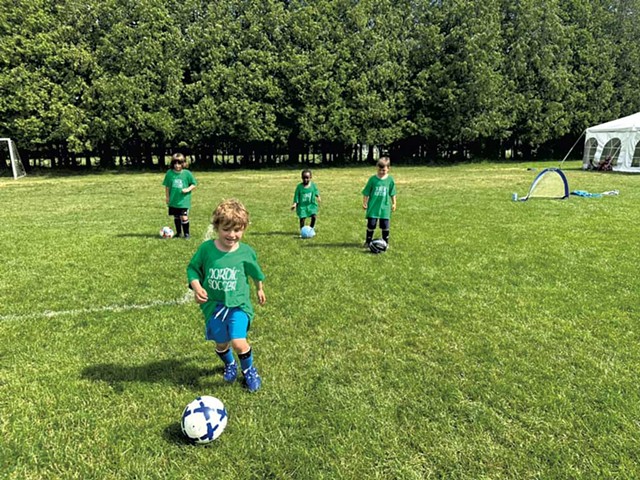
- Courtesy
- Nordic Soccer Club players at Tree Farm Recreational Facility
On pitches around the state, high school teams this week are heading toward their season finales — championship matches that mark autumn's twilight like leaf piles. Some players will move on to winter sports or other extracurricular pursuits following the three-month fall sports grind. But committed club soccer players will begin an entirely new season.
Club play will start indoors, carry through to late spring and cost upwards of $1,000, in some cases closer to $2,000, for tween and teen players to sign on with one of the five private premier clubs in the greater Burlington area: Burlington Football Club, Far Post, Nordic Soccer Club, Peak Football Academy (formerly Synergy Football Club) and Queen City Football Club.
Peak Football Academy operates in Vermont — as PFA New England — and from a Florida home base. It uses the "academy" designation to connote "playing at the highest competitive levels that you can," PFA president Jerry Davis said.
Other clubs, such as Queen City, dial back the intensity a notch and offer a soccer program with short-season options that create flexibility and reduce registration costs. (Disclosure: This reporter's children are former Queen City players who currently play a different club sport.)
But registration fees don't include gear, gas or tournament entries. Nor do they cover what can be expensive out-of-state tournament travel. Some clubs even take players abroad — Nordic to England, Burlington Football Club to Spain, Far Post to Holland. The Far Post trip costs about $3,700 per player.
South Burlington parent Nicole Hamlet, whose 16-year-old son has played for Far Post since he was 8, sees her parental involvement as akin to being a member of the team.
"The financial and time commitment is just as significant as the player's commitment to the sport," she said. Far Post and other club players will train twice a week on average, sometimes more. "You're essentially making that happen for them. It's not just the tuition," she added, tallying new uniforms for a growing kid, team fundraising activities and "all the weekends away ... It's a major commitment."
Despite the considerable costs, to equate Vermont soccer clubs with Dure's "rabid capitalism" is to misrepresent their goals. As Far Post club director Todd Kingsbury put it, his nonprofit organization's ultimate aim is not to make money but "to grow the game of soccer."
His club's balance sheet, according to data made available by ProPublica, backs up that claim, showing annual revenues around $1 million but overhead expenses that make Far Post a financially lean operation. Facilities rentals are a major line item for area clubs in a state that lacks the large youth soccer complexes found in more populous markets.
"The money of it all is challenging," Kingsbury said, adding that Far Post offers scholarships and takes other measures to fill in players' financial gaps. "If you can't pay for this, we'll make anything happen for you. We give away a lot."
Burlington Football Club has made overcoming financial hurdles an integral part of its mission. The scholarship page on the club's website invites players explicitly "regardless of their ability to pay."
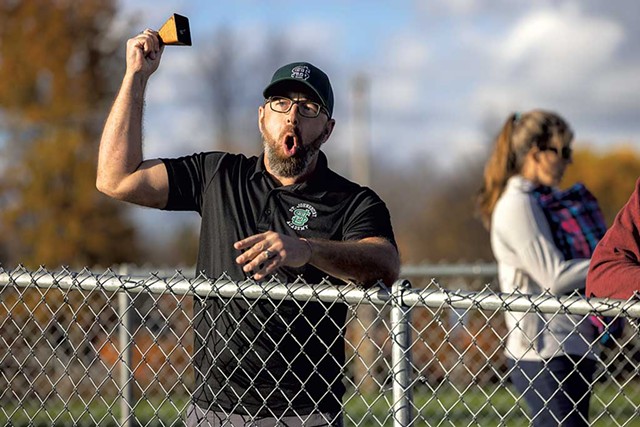
- James Buck
- Team spirit running high at a playoff match
According to executive director Kyle Marlow, while Burlington Football Club is open to players outside the Queen City, the organization grew out of a desire to meet the Burlington community at the intersection of interest and need — and "to fight the pay-to-play model," he said. "Support[ing] kids in a system that we know is flawed is something we can do."
When Marlow looks at the Burlington Football Club teams, he sees rosters that reflect the city's diversity. When he looks at the organization writ large, he sees a group of people who can step up to address the myriad challenges of access beyond cost: transportation, chaperoning out-of-state trips, being flexible in the face of players' unique needs. "This is where the community piece comes in," he said.
The need for that back-end support, whether from the community or elsewhere, may explain Davis' observation that dropout rates are higher among scholarship players at Peak Football than players who can pay their way. That suggests money isn't the only limiting factor for some players — it's having a support system with the time and resources to enable involvement.
"That's what I'm interested in," said Kristin Allosso, Burlington Football Club board member and scholarship coordinator. "BFC works really hard at fundraising and finding kids who want to play ... If we're going to offer this, we're going to offer it all-in."
Peer Pressure
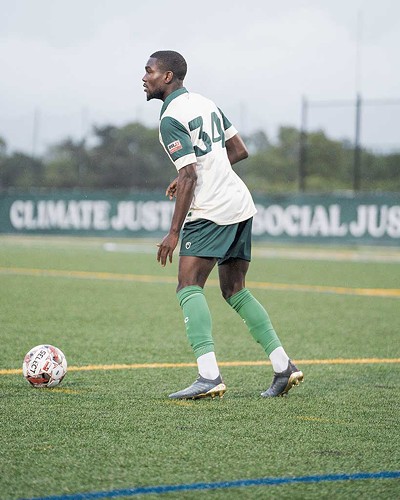
- Courtesy Of Joshua Wallace
- Amerlin Nemeye
In school sports, at least the price is right. But the dynamics become complicated when club sports and school sports intersect.
The club-to-school pipeline is now a fixture of Vermont youth soccer, with one return on club investment being a prized school A team or varsity spot. At the start of the current season, Burlington Free Press sports reporter Alex Abrami posted on social media the 2023 returning Vermont high school girls players to watch — roughly a dozen of whom, Nordic Soccer noted in a repost, are current or former Nordic players.
And that was just Nordic's share of the hotshots. Rob Cole, head coach of the perennially competitive Champlain Valley Union High School boys' varsity soccer team and also a Far Post board member and former coach, estimated that "virtually all of the players" on his current squad also play or have played recently for clubs.
Amerlin Nemeye played over the summer for Vermont Green Football Club, a semiprofessional team that launched in Burlington two years ago. He's also a 2018 South Burlington High School grad who remembers there being just a couple of non-club players on his varsity team. What's more, he said he might have failed to make varsity were it not for club soccer.
After emigrating from the Democratic Republic of the Congo in 2013, Nemeye had a rocky start at SBHS and didn't impress the coaches his first year. In between seasons, he joined Queen City, where founder and coaching director Shane Bufano guided his game to next level.
"From there, I knew I was going to be on varsity," Nemeye said. "When you're playing for a club, you treat it like it's a job." (Nemeye later played at Norwich University, where he earned a degree in 2023.)
Burr & Burton Academy senior and varsity soccer player Calum Morrell, a member of the Vermont Principals' Association student advisory board, notices the difference between year-round and club players and those, like himself, who only play for the school. "It's not only tactical," he said. "The kids that are around it more just have a better grip on the game."
"The clubs are developing the players," Munson concurred. "The high schools then get to — and middle schools, even — reap the benefits."
That's all good news for club players and fans cheering on their school teams, but it adds pressure to making the cut. In some school programs, such as in the Burr & Burton and CVU boys' teams, players who fail to make the varsity squad their junior year do not have the opportunity to play junior varsity.
"They're not easy conversations," Cole said. "It's the worst part of the job." He said he sends these players off with encouragement, specific guidance about how to up their game and the invitation to try out for varsity again senior year.
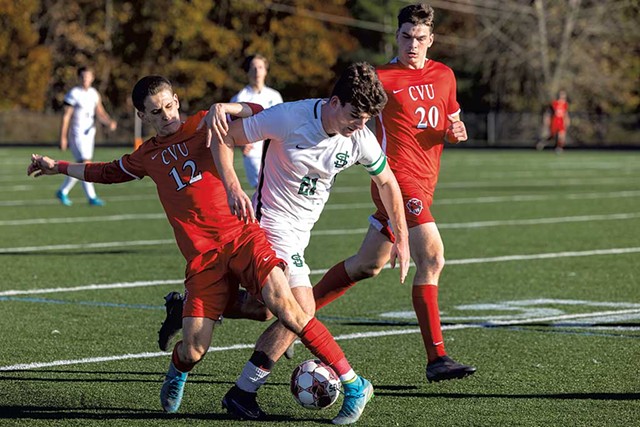
- James Buck
- Champlain Valley Union High School's Caleb Greenslit and St. Johnsbury Academy's Aidan Brody contest possession with Nick Menard in support.
What may seem like a cutthroat system is, Munson and Cole agree, often necessary, given the number of youths interested in playing in some districts. Cutting players also shows the competitive ethos driving high school sports. "When you have a state championship, that means you better put your best team forward," Munson said.
For some school athletics administrators, such as Quaron Pinckney, head of athletics for the Burlington School District, access is a priority. Pinckney oversees a district with a "no cuts" approach to school sports — and many B and junior varsity teams as a result. Juniors and seniors can still play JV soccer if they don't make varsity.
Pinckney acknowledges the social dimension of sports participation, which "begins to heat up" in middle school, he said: "Kids start to really, at that age, think about what their peers think of them." He cautions against undervaluing the rookie's contribution — both for how it affects a youth's sense of belonging and for what a sports newcomer might offer the competitive cause down the line.
"You never know how a kid is going to develop ... when they are literally first starting the sport," he said. "They could end up being the star of your varsity high school program."
Thomas of the Vermont Principals' Association agrees, noting that some students facing their first opportunity to play organized soccer in middle school may not have much prior exposure to the sport — or any sports — due to "a disparity of access" between urban and rural districts.
"Not every town has a rec department, and the strength of those rec departments is usually volunteer-based," she said.
Wolcott Elementary School principal Dennis Hill, an experienced statewide school administrator, has coached middle and high school football in athletic programs across Vermont. "Where there's a greater level of resources, there's a higher level of expectation around performance," he said. "To some degree, that gives some of these kids in these rural districts a disadvantage" when it comes to engaging them in sports. The stigma of poverty, he added, can be a barrier to peer-group membership, including sports teams.
"Access isn't just about money," he said. "It's sometimes about social acceptance."
Boot Camp
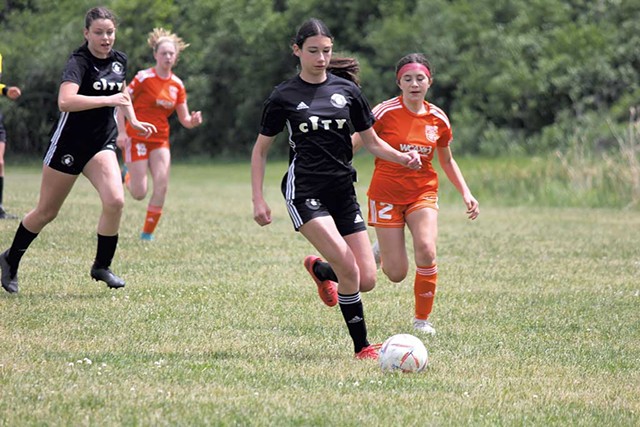
- Courtesy Of James Agnew
- Far Post Soccer Club (in orange) versus Queen City FC
That sense of belonging so vital to youth identity may sustain itself on enjoyment. In other words, if kids aren't having fun playing soccer, they won't keep playing. That was one observation that circulated through U.S. soccer officialdom when a dip in youth participation set off alarm bells in 2018. According to Munson, those numbers still concern state soccer leaders.
At a recent meeting with JT Batson, CEO of U.S. Soccer, Munson heard worrisome news that kids are dropping out of soccer earlier and earlier. Today's young players are calling it quits at age 10, down from 13 just five years ago. She suspects one factor may be the intensity of play at very young ages.
Kingsbury sees it at Far Post. "I'm starting these conversations with parents when the kids are 3 and 4 and 5 years old," he said.
Munson praised the work that town recreation leagues do to bring kids into the sport more playfully. "It's fresh air and running around. And there's not a whole lot of instruction, which is fine," she said. "We need more of that. We need kids to just be able to play."
In the soccer ecosystem, community-based club teams, such as Vermont Northern United and Essex United, create a middle ground for organized play. They're priced more moderately than premier clubs — a few hundred dollars per season, sometimes less — and proliferate statewide.
"Accessibility in both cost and location are equally important in being able to provide this opportunity for the kids in our community," said Kyle Ashton, copresident of Vermont Northern United. Also a Bellows Free Academy-St. Albans boys' soccer coach, Ashton sees his club as a flexible, inexpensive option for players to improve skills over more than one season in a part of the state where schools rely on multisport athletes to build rosters.
Not all community clubs include teams through middle and high school, however. When they do, those age groups may see a falloff in participation, such as Essex United president Adam Smith has observed, as players either join premier clubs, focus on their school team or quit soccer. While Essex United is "stable," Smith said, with about 200 players ranging from age 4 to 14, the club doesn't offer a fall season. He added that the decision to play only in spring is sensitive to volunteers' time, finite coaching resources and the fact that "we can't offer the same kind of programming that the private clubs can offer."
The national soccer story paints premier clubs in a predatory light, raiding town-based teams to nick players. In Vermont, the relationship is more neighborly. While Kingsbury acknowledged that "one of the downfalls of club soccer is pulling kids away from their towns," he has also worked with town teams, such as Essex United, to offer coaching clinics.
Smith welcomes the support. "There's a good partnership with all the clubs, honestly," he said. "We just want to play a lot of good, competitive games."
Higher Grounds
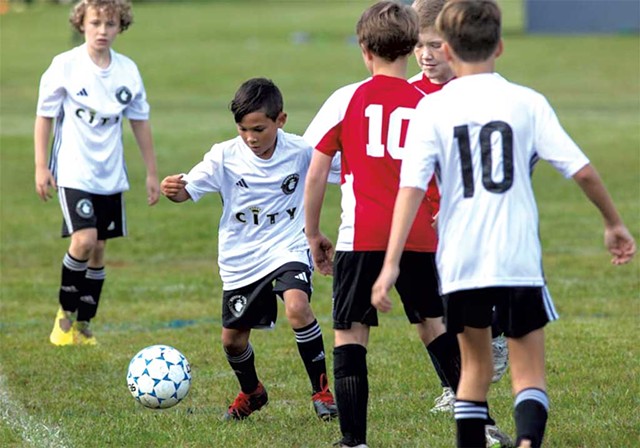
- Courtesy
- A Queen City Football Club player navigates defensive pressure.
If the Vermont soccer community functions, at times, like an actual community, the overarching rules of play — the powerful market forces that shape access — still put a uniquely American spin on the world's game. Competitive player development in the U.S. migrates from elite youth clubs to colleges and universities — another type of pay-to-play system.
Statistically speaking, banking on club soccer for a college scholarship isn't the safest bet. According to an NCAA survey, a mere 1.1 percent of U.S. youth soccer players receive scholarships at the Division 1 level. That's out of the less than 10 percent of youth players who go on to play in college overall.
But playing in a soccer club and on a high school team can boost those odds. Data gathered in 2019 for the NCAA GOALS (Growth, Opportunities, Aspirations and Learning of Students Enrolled in College) survey showed that 77 percent of men and 88 percent of women playing collegiate soccer had played on club and high school teams, compared to 13 and 6 percent of men and women, respectively, who had played only on club teams. An even smaller number played only on high school teams.
Kingsbury can rattle off the names of Far Post alumni who have gone on to play on college varsity teams. Many more, he said, find ways to keep playing on college intramural and club teams. Nordic Soccer can make similar claims, including a connection to Vermont Green FC's first signed player, Oliver Martin, a Williston native and Nordic alum now on the University of Michigan roster. PFA New England is sending youth groups from Vermont to the prestigious Disney Soccer Showcase, a prime college recruiting event.
Nevertheless, athletic director Pinckney said he has received enough parent feedback in his school district to harbor questions about "false promises" and "unrealistic expectations" at clubs.
As athletes and fans flip the calendar to a new season, Pinckney offers a timely reminder that pay-to-play is an evergreen feature of the youth sports landscape: "Really, it's not just soccer. Hockey is an example. Basketball is another example," he said. "There are many sports where there's that pressure to try to remain competitive while going to those private clubs, private leagues. And expense is a big piece of access."
Soccer mom Hamlet widens the lens further, calling out pay-to-play for limiting youth opportunity while acknowledging her own stake in it: "I totally don't think it's fair at all. However, we live in a world where things aren't fair," she said. "And I know that's a privileged thing to say ... It's problematic in the same way that parents can put their kids into SAT prep classes and pay college coaches for applications and do all the things to get their kids ahead that other families can't necessarily do."
For club directors such as Marlow, pay-to-play could keep kids from soccer's lifelong learning outcomes. The sport "is a tool to teach how to be ... a good, functioning person within our community," he said.
Morrell, now hanging up his soccer cleats and busting out his basketball sneakers at Burr & Burton, also sees sports in a wider context of growth experiences.
"Not only am I benefiting from physical exercise but also from having a sense of belonging within a group of people, within a team — feeling like you're part of a family," he said. "Having a sense of leadership and that people depend on you is really important to learn."
Correction, November 5, 2023: An earlier version of this story misstated Rob Cole's current role at Far Post Soccer Club. He is a board member and former coach.










Comments
Comments are closed.
From 2014-2020, Seven Days allowed readers to comment on all stories posted on our website. While we've appreciated the suggestions and insights, right now Seven Days is prioritizing our core mission — producing high-quality, responsible local journalism — over moderating online debates between readers.
To criticize, correct or praise our reporting, please send us a letter to the editor or send us a tip. We’ll check it out and report the results.
Online comments may return when we have better tech tools for managing them. Thanks for reading.